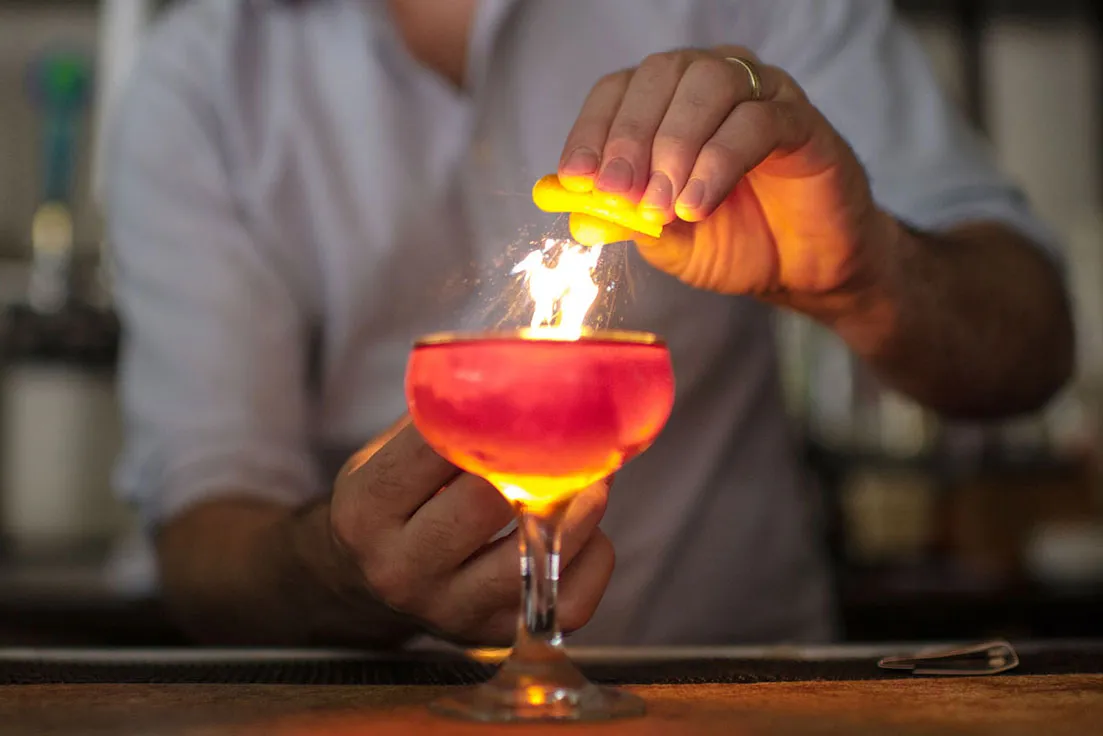This blog will help you to master all the fundamental Cocktails With Orange Peel Garnishes NYT, from skewering berries, cherries, and olives to cutting citrus into exquisite wheels and wedges.
Cocktails With Orange Peel Garnishes NYT: Mastering Orange Peel Garnishes for Your Cocktails

What is a garnish?
Two purposes of a cocktail garnish are adornment and taste improvement. Although all Cocktails With Orange Peel Garnishes NYT give some visual appeal, many also give the drink taste or aroma.
Certain cocktails taste rather different without the garnish (such as an Old Fashioned without an orange twist or a traditional Mai Tai devoid of mint). Don't overlook the garnish; it will really enhance your handcrafted artisan cocktails.
Read Also: Green Tinted Cocktails NYT: The Art of Green Tinted Cocktails
How should one cut oranges for cocktails?
Rounding Orange Slice
All you have to do is cut the ends off and then, with a standard serrated knife, cut a circle slice the same width as the top of the glass, the simplest of decorations, quick to prepare even for the most novice. Cut a little slit in the pulp and the peel and slot onto the edge if you want it on the glass.
Round Orange Half Slice
Cutting the spherical slice in half will produce a smaller slice of orange, the most often used garnish. If you want more flavor, leave it thicker or for a more subdued stay on a thin cut; you can play somewhat with the thickness.
Orange Energy
Orange zest is a thin strip of orange peel that smells rather strongly; you cut easily without having to dig too far into the skin. Thanks to its essential oils, this is an excellent garnish for many cocktails; but, obtaining the orange zest is simpler than you would expect. Making the traditional orange zest: garnish in four simple stages
Squeeze it slightly over the glass to accentuate the notes of your drink with delicate orange scent before adding it.
With a potato peeler or paring knife, cut a tiny bit of peel into a strip then remove pith.
Halved into quarters
Holding the orange firmly with one hand, use the other to etch the skin in a thin "slice," maybe free from the bitter white patina.
Lean 45 degrees from the glass and compress it.
Put it in your cocktail and let it soak for a little bit.
Twist with orange peel
Although we're getting creative, this is a simple approach to produce a lovely garnish without becoming too technical. This is the beginning of a garnish adventure.
Three simple steps for an orange peel twist
Cut a rectangle section of peel then cut off extra pith.
Sheer off the edges for straightness and cut the ends at acute angles.
Stuck between your fingers, slide it along the tumbler's edge.
You might drape it on the edge or coil it onto a coloured toothpick and balance across the glass's central axis.
spiral orange peel
Although slightly more complex to build, the spiral is a terrific variation on the spiral and has excellent visual appeal. The final result is so beautiful that you'll be wow your friends in no time.
Using five simple steps, create an orange peel spiral:
For the Twist, cut completely around the orange's midsection and repeat steps 1 and 2.
Roll into a tight coil from one end.
Slice the coil such that you produce evenly breadth separate peels.
Roll the peel around a straw or cocktail stick.
Remove the spiral gently then drape over the tumbler's edge.
Visit my Art of the Cocktail Garnish for more on garnishes and their part in the cocktail sipping experience.
Required garnish utensils
You'll want a good sharp paring knife for garnishes. This is the only essential utensil for creating cocktail garnishes; although, adding a pair of kitchen scissors and a Y-shaped vegetable peeler to your collection will greatly simplify things.
I make use of The Almost 4’s knife and The Good Shears from Material Kitchen (above). Originally given to me, these tools have evolved into my first choice over time due of their exceptional quality and sharpness. Investing once in quality tools is much advised instead of constantly buying new, inexpensive tools over and again.
Using scissors instead of a knife while cutting citrus peel Cocktails With Orange Peel Garnishes NYT helps one more easily control the shape of the peel. Quickly remove rough edges with a pair of sharp kitchen shears, then cut the peel into a clearly defined rectangle or other form.
Over the years, I have gone through a lot of vegetable peelers; my top selections for good quality, sharpness, and economy are the Honsen Ultra Sharp Stainless Steel Peeler (seen above) and the Kuhn Rikon Original Swiss Peelers.
While using a knife is far more perilous, a Y-shaped vegetable peeler makes rapid work of peeling citrus fruits. Get yourself a peeler if you have poor knife skills or a tendency for accidents! Their low cost makes the smooth, thin, equally cut peels well worth it.
Read Also: How to Plan a Cocktails Birthday Party
How should citrus garnishes be sliced?

Fresh citrus like lemons, limes, or oranges is the most often used cocktail garnish. Citrus fruits give zesty, vivid smells and flavors that can boost the whole freshness of a drink as well as change the taste sensation of sweetness.
See my description of the eight tastes to learn more about how flavors interact. We will walk over how to cut and use four main citrus garnishes.
Citrus wheel:
The easiest to cut, the citrus wheel always looks great in a glass or on the rim. Wheels bring some juicy taste from the fruit's flesh and scent from the oils in the peel.
Holding the fruit by one end—the base or the top—cut a citrus wheel straight through the middle of the fruit. You will now have two halves, each highlighting the fruit's inside circular, wheel-like form.
How would you garnish a margarita?
Now hold each half by its end and cut them into many ¼“ thick sections. An ordinary-sized orange will produce some less appealing little wheels from each end and roughly six to eight perfectly formed wheels.
Cut a slit from one edge of a citrus wheel into its center to seat it on the rim of a glass. Watch not to cut it all the way through to the other side. Now down onto the glass's edge the wheel slit-side.
Citrus cuts
Once you can cut a wheel, mastering a citrus slice is quite easy. You will get two slices just by halfing every wheel!
Citrus wedges: two approaches
Margaritas and Gin & Tonics are two beverages where citrus wedges are rather popular garnishes. Customizing the degree of acidity, a wedge allows the drinker to squeeze a small amount of that crisp lime or lemon flavor into their drink.
FAQs: Cocktails With Orange Peel Garnishes NYT
What is the orange peel called in cocktails?
Often employed in the food and drink sector to accentuate the taste and presentation of foods and beverages, an orange twist is a flexible and aesthetically pleasing garnish. Usually with a citrus zester or a sharp knife, it is made from peeling a thin strip of orange zest from the outside skin of an orange.
How to garnish with citrus peels?
Cut a coin of at least one inch width and roughly two inches length out of the orange peel with a paring knife.
Drop the peel into the liquid after rubbing it all around the glass's rim.
How to make orange peel for Negroni?
Cut off an orange's peel.
To a glass add one ounce of gin.
To the glass put one ounce of sweet vermouth.
To the glass add one ounce of campari.
Put ice in the Negroni.
Stir to mix.
Over the glass flame the orange peel. Drop in and wipe the rim with the orange peel.
Present the Negroni right once.
What is the difference between Aperol and Campari?
Depending on where it is served, campari—a deep red—has 20.5 to 28.5 percent alcohol by volume (ABV), twice that of Aperol. Given its vivid orange hue and generally friendliness over Campari, Aperol is the younger sibling. With about 11 percent ABV level, aperol is sweeter than Campari.




